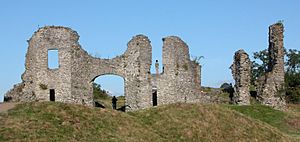Newcastle Emlyn Castle facts for kids
Newcastle Emlyn Castle (which is Castell Newydd Emlyn in Welsh) is a very old, ruined castle in the town of Newcastle Emlyn, Wales. It's in a great spot, high up on a piece of land looking over the River Teifi. A Welsh lord named Maredudd ap Rhys probably built it around the year 1240.
Over many years, the castle was captured and recaptured in battles. This happened between the Welsh and the English, and later during the English Civil War. Today, you can still see parts of the main gatehouse and some nearby towers. There are also a few pieces of the old walls left.
Contents
History of the Castle
Early Days and Welsh Builders
The castle at Newcastle Emlyn was first mentioned in an old Welsh book called Brut y Tywysogion. It said that Llywelyn the Great took control of it. But this was likely an even older castle made of wood.
The stone castle we see today was probably built by Maredudd ap Rhys around 1240. If this is true, it's special because not many castles in West Wales were built by the Welsh using stone.
Battles and Sieges
In 1287, Maredudd's son, Rhys ap Maredudd, started a rebellion against the English. He was trapped at Dryslwyn Castle. When that castle finally fell, he escaped to Newcastle Emlyn Castle.
The English army had a huge siege engine (a giant war machine). They moved it from Dryslwyn to Cardigan using forty oxen! Then, they brought it up the Teifi Valley to Newcastle Emlyn. This time, they needed sixty oxen because it was such a hard journey!
The castle held out for a while, but it eventually fell to the English. This ended Rhys ap Maredudd's rebellion.
The Black Prince's Castle
Newcastle Emlyn Castle was one of 26 castles owned by Edward, the Black Prince. Most of these castles were in Wales. He became the owner when he was made Prince of Wales in 1343.
During his time, the castle was peaceful and stable. One person who looked after it, Richard de la Bere, stayed in his job for nineteen years!
Later Conflicts and Ruin
The Welsh captured Newcastle Emlyn Castle in 1403. This was part of a big Welsh uprising led by Owain Glyndŵr. The castle was fixed up in the 1400s and was in good shape in the early 1600s.
The castle also played a part in the English Civil War. It changed hands many times during the fighting. In 1645, it was attacked by Parliamentary troops. Around 1700, a document said the castle had been "taken apart in the late Civill warres and robbed and ever since ignored."
Even though the castle has a long history, a proper map of the site wasn't made until 1985.
What the Castle Looks Like Today
Location and Main Entrance
The castle is built in a bend of the River Teifi. This means it's almost surrounded by water. You can only get to it by land from the west side.
The main part of the castle, called the inner ward, is shaped like a triangle. You enter it through a large gatehouse that has two towers.
Gatehouse Features
The towers on either side of the gateway are round on the outside but square inside. Under the north tower, there's a well-preserved vaulted cellar. This is like a basement with an arched ceiling.
You would have reached the top floor of the gatehouse by an outside staircase. This staircase might have also led to a walkway on the curtain wall. This wall went all the way around the castle, but not much of it is left today.
Later on, toilets (called latrines) were added on both sides of the gatehouse towers. Sir Rhys ap Thomas also added bigger windows around 1500.
Other Castle Buildings
Just south of the gatehouse, there's a square tower. You can still see parts of it. The great hall, where people would have gathered, was nearby. There was also a chapel, a kitchen, and a larder (a food storage room). Another building seemed to be to the east of the gatehouse. Sadly, none of these buildings can be seen above ground today.


